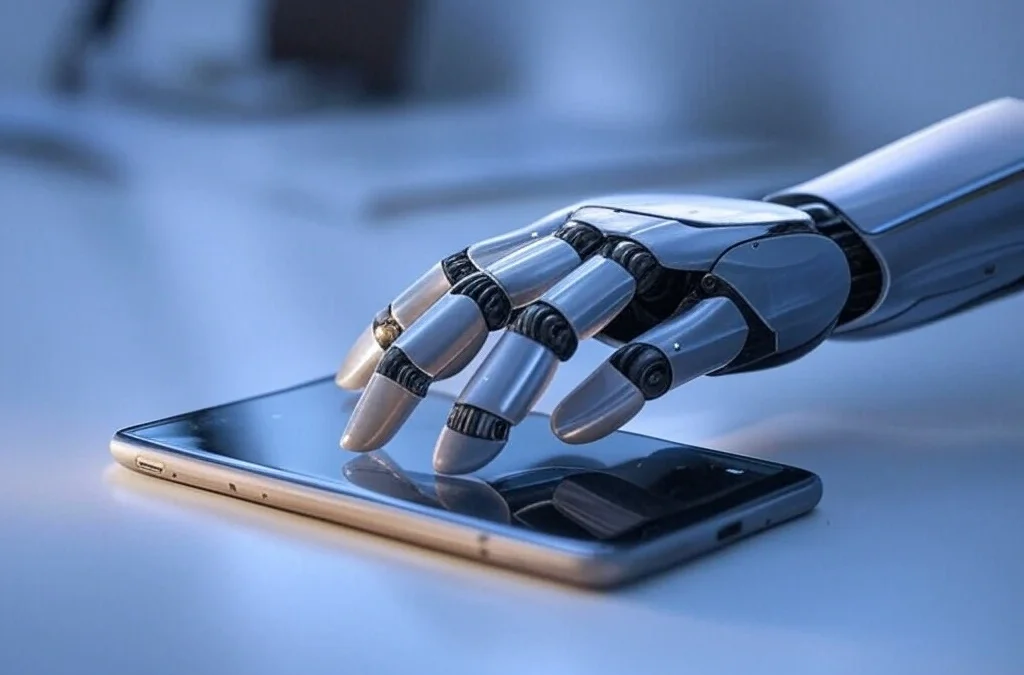We all know someone who seems naturally clever. Maybe they pick up new skills quickly or always have the right answer. Being smart isn’t just about book smarts or having a high IQ. It shows up in many forms – from problem-solving and adapting to new situations to creating helpful tools and systems.
This list explores 50 examples of smartness in our world. From the latest tech gadgets to amazing animals and brilliant human creations, these examples might help you spot your own strengths and hidden talents. After all, recognizing different types of intelligence can help us understand our own gifts better.
50 Things That Are Smart
When we say something is “smart,” we usually mean it’s clever, efficient, adaptive, or capable of making decisions. From gadgets and animals to systems and ideas, here are 50 things that are genuinely smart—and why they earn that label.
1. Smartphones
They’re the most obvious place to start. A smartphone is a pocket-sized computer that connects you to the world, helps you navigate, translates languages, tracks your health, and lets you do everything from shopping to editing videos. That’s more than just a phone—it’s a smart assistant in your pocket.
2. Smartwatches
These aren’t just glorified timepieces. Smartwatches monitor your heart rate, sleep patterns, steps, and even notify you if your heartbeat is irregular. Some can even detect falls and call for help. Talk about wearable intelligence.
3. Dolphins
Dolphins are among the smartest animals in the world. They recognize themselves in mirrors (a sign of self-awareness), understand complex instructions, and even call each other by unique names using whistles. Nature didn’t skimp on brainpower here.
4. Thermostats (like Nest)
A smart thermostat learns your habits—like when you wake up, leave home, or go to bed—and adjusts the temperature automatically to save energy and keep you comfortable. That’s both eco-friendly and economically smart.
5. Crows
Crows use tools, solve puzzles, and can even recognize human faces. Studies show they hold grudges and pass knowledge on to their peers. Not bad for something with feathers.
6. Smart TVs
A smart TV connects to the internet, lets you stream content from Netflix to YouTube, and often has voice control built in. It’s more than a screen—it’s your home entertainment hub with a brain.
7. AI Chatbots (like ChatGPT)
Modern chatbots understand natural language, answer questions, write articles, and even help you code. They’re revolutionizing how we interact with technology. Smart, adaptive, and always learning.
8. Octopuses
Octopuses are escape artists and problem solvers. In labs, they’ve opened jars, used tools, and even played pranks. Their intelligence is eerie—some scientists call them “aliens on Earth.”
9. Smart Home Assistants (like Alexa or Google Assistant)
They control your lights, music, reminders, shopping lists, and even your smart locks or thermostat. Just speak, and your home responds. That’s automation made intuitive.
10. Elephants
Elephants have incredible memories, form deep social bonds, and even mourn their dead. Their emotional intelligence is staggering.
11. Smart Lights
These lights adapt to your schedule, dim or brighten based on mood, and some even mimic natural light cycles. Convenience meets energy efficiency.
12. Ravens
A close cousin of the crow, ravens plan for the future and understand cause and effect. One study showed they can trade tokens for food—thinking ahead like humans do.
13. Smart Fridges
Yes, even your fridge is getting clever. Some can scan what’s inside, suggest recipes, or let you peek inside while grocery shopping via your phone. It’s a kitchen upgrade with brains.
14. Chess Masters
Chess is a game of strategy and foresight, and grandmasters think 10–15 moves ahead. Human intelligence doesn’t get more elegant than this.
15. Smart Locks
Ditch the keys. Smart locks let you unlock your door with your phone, give temporary access codes, and notify you when someone enters. Safer and smarter.
16. Border Collies
They’re considered the most intelligent dog breed. They follow commands quickly, understand human language, and can herd animals with minimal direction.
17. Smart Mirrors
These futuristic mirrors display the weather, your schedule, or health stats while you brush your teeth. It’s like a morning dashboard for your life.
18. Bees
Bees aren’t just busy—they’re brilliant. They communicate through dances, make collective decisions, and navigate using the sun. Their tiny brains do a lot.
19. Smart Plugs
They turn any regular appliance into a smart one. With an app, you can schedule your coffee maker, turn off a lamp remotely, or track energy usage.
20. Whales
Whales use complex songs to communicate across vast oceans and display social intelligence that’s only starting to be understood.
21. Smart Toilets
Yes, even toilets can be smart now. From automatic flushing and bidet functions to heated seats and health sensors, they bring hygiene to the high-tech era.
22. Ant Colonies
No individual ant is especially smart, but together, ants form a superorganism. Their colonies are models of coordination and efficiency.
23. Smart Cars
Cars with adaptive cruise control, automatic braking, and lane assist are making driving safer. They’re the stepping stone to full self-driving vehicles.
24. Parrots
Some parrots can use words meaningfully, understand categories, and solve logic puzzles. One African grey parrot named Alex could count and identify shapes and colors.
25. Smart Sprinkler Systems
They adjust watering schedules based on weather forecasts and soil moisture levels, saving water and keeping your garden green.
26. Humans
Let’s not forget ourselves. Our ability to reason, create, and reflect makes us unique—and when we use that intelligence to help others or solve real problems, that’s smart living.
27. Smart Glasses
Beyond correcting vision, smart glasses can display notifications, translate text, or even record videos. Augmented reality is now wearable.
28. Bonobos
These primates show empathy, cooperation, and even use tools. Their social smarts rival those of humans in many ways.
29. Smart Grids
These electrical grids use sensors and AI to manage power distribution efficiently, detect outages, and support renewable energy sources.
30. Slime Mold
It sounds gross, but slime mold can solve mazes and optimize routes—even without a brain. Scientists study it for insight into decentralized intelligence.
31. Smart Cities
From smart traffic lights to waste management systems and environmental sensors, cities are becoming more connected and efficient every year.
32. Capuchin Monkeys
These monkeys use tools, understand currency-like exchanges, and even wash their food. Small brains, big thinking.
33. Smart Speakers
They play your favorite tunes, answer trivia questions, control your smart home, and even tell jokes. They’re part of daily life in many households.
34. Orcas
Also called killer whales, orcas teach their young to hunt, use complex vocalizations, and pass on culture within pods.
35. Smart Sensors in Cars
Tire pressure monitors, collision sensors, and backup cameras all help you drive better and safer without thinking twice.
36. Apes in Research Labs
Many apes have learned sign language and can communicate emotions, needs, and even abstract thoughts.
37. Smart Luggage
Track it with GPS, charge your phone, and even get notifications if it’s opened. Travel gear has evolved.
38. Financial Algorithms
From stock trading bots to budgeting apps, smart finance tools analyze trends and help people (and companies) make better money decisions.
39. Smart Cameras
These recognize faces, detect motion, and can even tell the difference between humans and animals. A major boost for home security.
40. Cephalopods (Squid and Cuttlefish)
These brainy sea creatures use camouflage, solve problems, and show signs of learning and memory. Ocean IQ at its finest.
41. Smart Notebooks
Write by hand, and it digitizes your notes instantly. They’re perfect for students or professionals who want analog comfort with digital convenience.
42. Smart Retail
Stores using AI track customer behavior, predict inventory needs, and personalize offers—turning shopping into a data-powered experience.
43. Smart HVAC Systems
Heating and cooling are expensive—these systems learn your preferences, monitor air quality, and keep your energy bill in check.
44. Tool-Using Birds (like New Caledonian crows)
These birds craft hooks and other tools to extract food—basically avian engineers.
45. Smart Farms
Drones, soil sensors, and predictive software help farmers grow more with fewer resources. Agriculture is smarter than ever.
46. Digital Personal Assistants
From Siri to Bixby to Cortana, these virtual helpers schedule meetings, send messages, and answer voice queries, making everyday tasks simpler.
47. Smart Recycling Bins
Some bins now scan what you toss, sort materials correctly, and provide feedback on how to recycle better. Waste reduction with intelligence.
48. Self-Driving Tractors
Autonomous tractors plant, water, and harvest crops with precision. A smart solution to labor shortages and efficiency challenges.
49. Smart Sleep Devices
Track your sleep cycles, wake you up gently at the right time, and offer insights into your rest patterns. Because being well-rested is smart, too.
50. Algorithms That Detect Disease
AI can now scan medical images and detect signs of cancer or heart disease earlier than doctors in some cases. It’s one of the most life-saving forms of smart tech today.
What Is a Smart Thing?
A smart thing is any object, device, system, living being, or concept that demonstrates the ability to adapt, learn, make decisions, solve problems, or improve efficiency—often by using intelligence, technology, or instinct. The term “smart” is used to describe not just gadgets and electronics, but also animals, strategies, tools, and even natural systems that show an impressive level of cognitive function or functionality.
In the modern world, smart things often include AI-powered technology, such as smart home devices, smart cars, or smart wearables. These items use sensors, data, and artificial intelligence to respond to your needs, optimize performance, or make daily life easier. For example, a smart thermostat learns your routine and adjusts your home’s temperature accordingly, saving energy without you lifting a finger.
But not everything smart needs a circuit board. A dolphin using tools, a crow solving puzzles, or a bee navigating complex communication systems are also examples of smart things in nature. These are forms of biological intelligence—evidence that being smart isn’t limited to digital devices.
In short, a smart thing is something that thinks, adapts, or functions in a way that’s clever, efficient, or highly effective—whether it’s powered by code, instinct, or conscious thought.
Common characteristics of smart things include:
-
The ability to learn or adapt over time
-
Problem-solving skills or logic-based behavior
-
Efficiency or automation in tasks
-
Use of technology or intelligence to achieve better outcomes
-
Interaction with users, environments, or data in a meaningful way
This broad definition is what allows us to call a phone smart, a bird smart, a city smart, and even a business decision smart.
Synonyms of Smart
When we talk about something being smart, we often mean it’s clever, capable, or highly efficient. Here are some of the most important and commonly used synonyms for “smart”:
-
Intelligent
-
Clever
-
Bright
-
Sharp
-
Wise
-
Brilliant
-
Genius
-
Quick-witted
-
Brainy
-
Knowledgeable
-
Insightful
-
Strategic
-
Savvy
-
Resourceful
-
Adaptive
-
Innovative
-
Shrewd
-
Perceptive
-
Logical
-
Skilled
These words can apply to people, technology, animals, systems, and ideas—anything that shows the ability to think, learn, or perform well.
The 8 Types of Intelligence – Find Your Strength
Did you know there are many different ways to be smart? According to psychologist Howard Gardner’s theory, we all have multiple types of intelligence, but usually excel in a few specific areas. Here are the main types:
- Verbal-Linguistic – You’re good with words, writing, and speaking. You might love reading, telling stories, or learning languages.
- Logical-Mathematical – You enjoy puzzles, patterns, and numbers. Problem-solving comes naturally to you.
- Visual-Spatial – You think in images and understand maps, charts, and visual arts easily. You can picture things in your mind clearly.
- Musical – You’re sensitive to sounds, rhythms, and tones. You might pick up tunes quickly or always have a song stuck in your head.
- Bodily-Kinesthetic – You learn best by doing. Your coordination, balance, and physical skills are strong.
- Interpersonal – You understand people well and can read others’ feelings. You’re good at working in teams and resolving conflicts.
- Intrapersonal – You understand yourself deeply. Self-reflection and awareness of your own thoughts come naturally.
- Naturalist – You connect easily with nature and notice patterns in the natural world. You might be drawn to animals, plants, or the outdoors.
Looking at the 50 smart things in our list, which ones connect with your type of intelligence? A person with high musical intelligence might be fascinated by whale songs, while someone with logical-mathematical intelligence might appreciate chess or smart algorithms.
Read also:
The Most Popular on BitGlint

Top 100 Personal Items List
Everyone uses personal items in their daily lives, often without even thinking about them. From the moment you wake up...

30 Defiance Examples & Meaning
Defiance is something most people experience at some point in life. You feel it when you say no to something that...

Top 30 Desire Examples & Definition
Desire is a powerful force that drives much of human behavior, shaping our goals, dreams, and everyday decisions. It's...

100 Non-Digital Things List
In everyday life, there are still hundreds of objects, tools, and materials that exist completely outside the digital...

30 Examples of Attention & Definition
Have you ever noticed how a catchy tune can grab your attention, even when you're busy doing something else? It's...

60 Cultural Traditions Examples & Definition
Cultural traditions are part of daily life - whether people realize it or not. They shape what we eat, how we...

Top 30 Intimacy Examples & Meaning
Intimacy goes beyond physical touch or romantic moments. It’s about closeness, trust, and connection. In everyday...
Get Inspired with BitGlint
The Latest
40 Emotional Value Examples & Meaning
Why do some messages stick — while others are forgotten? Why do people choose one brand over another, even when the product is the same? The answer often comes down to emotional value. Emotional value is what makes a message feel human. It’s the emotional connection...

30 Teasing Examples & Definition
Teasing is a common part of human interaction. People tease in different ways, for different reasons. Sometimes it is friendly. Sometimes it can hurt feelings. Understanding what teasing means and seeing clear examples helps everyone handle these moments better....
40 Thought Experiments for Curious Minds
Some questions can’t be answered with a simple yes or no. Some problems don’t have a clear solution. That’s where thought experiments come in. They aren’t just old ideas from philosophy books. Thought experiments are tools we still use to think through problems, test...
30 Focus Examples & How to Improve Concentration
Focus is one of the most important skills in life. Whether you're working, studying, playing sports, or even having a conversation, your ability to stay focused can determine your success. But many people struggle with distractions, short attention spans, and mental...

